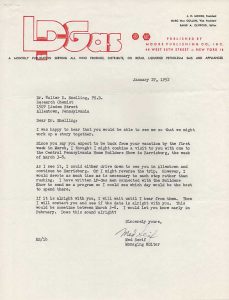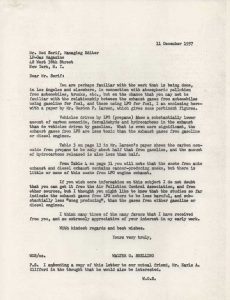LP Gas magazine a staple in propane’s history
The letters are real, typed on old LP Gas letterhead and faded white paper.
They’re sincere, informative and downright intriguing. And oh, by the way, they feature Walter O. Snelling, who uncovered the properties of propane in 1910 and paved the way for the industry’s first domestic users in 1912.
As you read the letters, you begin to see how two men – Snelling and former LP Gas Managing Editor Med Serif – developed a partnership, formed a friendship and established a foundation for an entire industry.
Jim Renaldo of Renaldo Sales & Service, president of the Young Gassers and one of several industry leaders working to preserve propane’s history at the National Museum of Industrial History in Bethlehem, Pennsylvania, shared the letters with us. They come from Marjorie Snelling, Walter Snelling’s granddaughter, who has contributed many of her family’s archives to the project.
Industry leaders hope to use these “gems” as part of a digital archive of historical documents at the museum, which already houses a propane exhibit, Renaldo says.
What the letters say
The letters span 10 years of the propane industry. They start early in 1952 when Serif is following up on the magazine’s request to visit Snelling at the chemist’s home in Allentown, Pennsylvania, and write a story about LP gas’ early history.
“I was happy to hear that you would be able to see me so that we might work up a story together,” Serif writes in a Jan. 29, 1952, letter.
The two discuss their schedules and settle on a March 4, 1952, meeting. Snelling is welcoming, as he offers to arrange accommodations for Serif at the nearby Hotel Traylor.
After the meeting, Serif asks Snelling for a photo of John Gahring to mark the 40th anniversary of propane’s first domestic user. On May 17, 1912, Snelling’s American Gasol Co. installed two cylinders at Gahring’s farmhouse near Waterford, Pennsylvania, to supply propane for lighting and cooking. Serif also asks for a few words from Gahring to describe “how he liked LP gas and how he feels about the strides LP gas has made.”
In response, Snelling notes that Gahring is his father-in-law and “anything that he might say in commendation of LPG would be from a prejudiced source.”
The collection of letters includes one from Gahring, who writes in 1952, “I am very proud to have been the first commercial user of LPG, but I must admit that in 1912 I did not anticipate the remarkable growth that the industry has since shown. Today, in the homes of both my children and some of my grandchildren, I enjoy the many comforts that LPG has brought to me, to them, and to so many million others, in this and in other lands.”
The meeting culminates in Serif’s May 1952 article titled “The First LP-Gas Customer.” Serif follows with similar articles acknowledging the industry’s first domestic customers.
Over this series of letters, Snelling seems to show a growing appreciation for Serif’s work.
“I have been so busy over the years that I have been reluctant to make claims covering my pioneer work in LPG, but I can assure you that it is pleasant to know that the importance of my early work is now, at long last, being recognized,” Snelling writes.
Photo: LP Gas Magazine


















